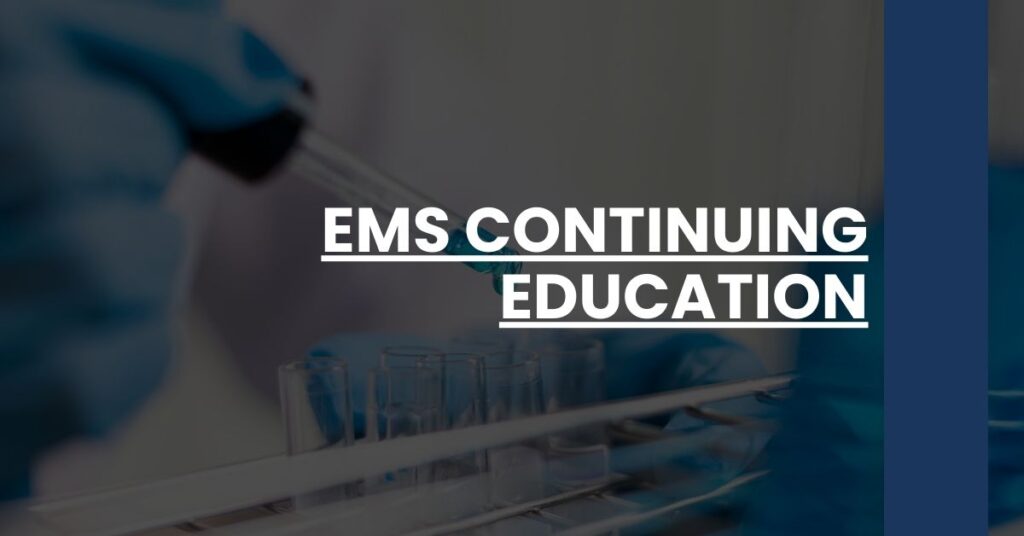EMS continuing education is essential for every emergency services professional looking to advance their skills and knowledge.
- Stay Current: Keep up with the latest EMS protocols and equipment.
- Maintain Certification: Meet the mandatory requirements to sustain your professional EMS credentials.
- Enhance Patient Outcomes: Improve the quality of care you provide through ongoing education.
Ensure your EMS continuing education journey is on the right track.
- Understanding EMS Continuing Education
- EMS Continuing Education Requirements
- Accredited Continuing Education Programs
- Online vs In-Person Learning Options
- National Registry of Emergency Medical Technicians (NREMT) Certification
- Innovative Formats For EMS Continuing Education
- Balancing Work and Education
- Funding and Support for EMS Continuing Education
- Practical Tips for Course Selection and Completion
- Tracking and Reporting Continuing Education Credits
- Conclusion: Embracing Lifelong Learning in EMS
Understanding EMS Continuing Education
Emergency Medical Services (EMS) professionals are known for their ability to respond to urgent health crises with speed and expertise. But to navigate the fast-paced evolution of medical procedures and technologies, EMS providers must engage in a continuum of learning — this is where EMS continuing education enters the frame.
The Essence of Continuing Education
Continuing education (CE) in the EMS realm represents a range of enriching learning experiences. Its core mission is to ensure that EMS providers remain equipped with cutting-edge knowledge and skills to improve patient outcomes. Engaging in EMS continuing education is not just about fulfilling regulatory requirements — it’s about nurturing a culture of clinical excellence.
Why CE is Crucial for EMS Professionals
In a practice where life and death decisions are made in split seconds, ongoing education is crucial. Here’s why:
- Updates on Clinical Practices: It keeps you informed about the latest clinical protocols and treatment strategies.
- Compliance and Standards: It helps you maintain state licensure and meet National Registry standards.
- Patient Safety and Outcomes: Through continuous learning, the safety and quality of patient care is enhanced.
- Personal Growth: It provides opportunities for personal and professional development.
EMS Continuing Education Requirements
To maintain proficiency, EMS professionals are required to meet specific CE requirements, often defined by a combination of state regulations and national certification bodies.
Hours and Course Types
Here is a general breakdown of how CE usually works:
- Hourly Commitment: You might face a requirement ranging from 20 to over 70 hours within a certain time frame, often two years.
- Course Categorization: Expect a mix of mandatory core subjects and electives that align with your scope of practice.
- Practical Components: Some CEs might include hands-on training, reflecting the physical nature of EMS work.
Though these CE hours seem daunting, remember, every course is a step towards excellence in patient care.
Accredited Continuing Education Programs
Navigating the seas of CE offerings calls for a compass pointing towards accreditation — a mark of educational quality and relevance.
The Accreditation Litmus Test
An accredited program assures that:
- The curriculum aligns with current industry standards.
- Instructors are qualified and experienced.
- The program is subject to regular peer-review processes for quality assurance.
- Credits earned are recognized by state and national certifying bodies.
By choosing an accredited CE program, such as those approved by the Committee on Accreditation of Educational Programs for the Emergency Medical Services Professions (CoAEMSP), you ensure your educational investment is sound.
Online vs In-Person Learning Options
For EMS CE, you have the liberty to choose between in-person classes and online learning — each with its distinct advantages.
Comparing Formats
- In-Person: Offers hands-on experience, real-time interaction with instructors, and networking with fellow EMS providers. However, scheduling and travel may pose challenges.
- Online: Provides flexibility and convenience, especially for fitting coursework around shift schedules. The trade-off can be less direct interaction and hands-on training, though many online courses are adept at simulating real-world scenarios.
National Registry of Emergency Medical Technicians (NREMT) Certification
Continuing education and NREMT certification are two strands woven tightly together, reinforcing each other to uphold a gold standard in EMS practice.
CE as a Pillar of NREMT Certification
The NREMT requires CE for recertification to:
- Maintain a uniform standard of care across states.
- Encourage continued competency in the face of evolving EMS challenges.
- Fortify the bridge between up-to-date knowledge and actual practice.
Managing your NREMT recertification with an understanding of the relevant CE requirements revalidates your commitment to both personal growth and public service.
Innovative Formats For EMS Continuing Education
In the dynamic world of emergency medical services, continuing education programs are consistently adopting innovative formats to enhance engagement and learning. Whether it’s through immersive simulations or interactive webinars, the goal remains the same: to ensure EMS professionals can deftly handle the diverse scenarios they’ll encounter in the field.
Inspiring Innovation in Learning
Diverse educational formats can make your journey through EMS continuing education not just informative but also genuinely engaging. Consider the following avenues:
- Virtual Simulations: High-fidelity simulations replicate real-life emergency scenarios, allowing you to apply your knowledge in a risk-free environment.
- Interactive Webinars: These live presentations offer the chance to learn from and interact with experts in the field, all from the convenience of your desk.
- On-demand Videos: Pre-recorded lessons allow you to learn at your own pace, providing a flexible option for busy schedules.
Each format has its unique strengths, but what they all share is a commitment to enriching your professional expertise.
Balancing Work and Education
As an EMS professional, juggling the demands of your career with the requirements of EMS continuing education can be a real challenge. But with the right strategies and mindset, this balance is not just possible; it’s an opportunity for growth.
Effective Time-Management Tips
Here’s how you can efficiently integrate CE into your busy life:
- Schedule Your Learning: Just as you would for shifts, allocate dedicated time slots for your coursework each week.
- Prioritize Your Tasks: Determine which assignments require immediate attention and which can wait, similar to triaging patients.
- Embrace Flexibility: Take advantage of online courses that fit around your shifts and offer the convenience of learning on the go.
With thoughtful planning, you can ensure that your education enhances rather than competes with your work responsibilities.
Funding and Support for EMS Continuing Education
Financing your EMS continuing education might seem daunting, but resources are available to support your professional development. Many EMS employers value your growth and are willing to invest in it.
Financial Support Strategies
To ease the burden of education costs, explore the following options:
- Employer Tuition Assistance: Some EMS services offer reimbursement programs for job-related courses.
- Scholarships and Grants: These are sometimes available through professional EMS associations or medical institutions.
- State and Federal Programs: Occasionally, government-sponsored programs can provide financial aid to healthcare professionals seeking further education.
Researching and taking advantage of such opportunities can make advancing your education more economically feasible.
Practical Tips for Course Selection and Completion
Navigating the vast landscape of EMS continuing education courses can be overwhelming. Knowing which courses to choose and how to successfully complete them is critical.
Selecting Relevant Courses
Here are key considerations for picking the right course:
- Align With Your Goals: Choose courses that not only meet regulatory requirements but also align with your career objectives.
- Evaluate Course Content: Look at course syllabi to ensure the content will be valuable for your practice.
- Seek Recommendations: Colleagues and online forums can be great resources for finding courses that have worked well for others.
And once you’ve selected the right courses:
Completing Courses Effectively
- Stay Organized: Keep careful track of deadlines and materials.
- Engage Fully: Actively participate in discussions, simulations, or assignments to get the most out of your learning.
- Apply What You Learn: Try to implement new knowledge and skills into your work routine to reinforce learning.
Applying these strategies can make the process of selecting and completing your CE requirements both rewarding and beneficial.
Tracking and Reporting Continuing Education Credits
Maintaining accurate records of your EMS continuing education is as vital as completing the courses themselves. Proper tracking ensures that your hard-earned credits count toward your certification.
Keeping Meticulous Records
A two-fold strategy is essential for managing your credits:
- Use Tracking Services: Many CE providers offer online tracking systems; familiarize yourself with these tools to streamline your record-keeping.
- Create a Backup: Maintain a personal, detailed log of your CE activities as a backup in case of discrepancies.
By diligently documenting your CE efforts, you’ll be well-equipped for straightforward reporting when the time for recertification arrives.
Conclusion: Embracing Lifelong Learning in EMS
Your commitment to EMS continuing education is a testament to your dedication to your profession, your patients, and yourself. This ongoing journey is not solely about maintaining certifications; it’s about elevating the care you provide every day.
Lifelong Learning is Lifesaving Learning
In your hands lies the power to save lives and change futures. With every course, every simulation, every learning experience, you’re not just gaining credits—you’re gaining the ability to make a difference. When you embrace EMS continuing education, you’re accepting the challenge to become the best EMS provider you can be. Welcome to the journey where each step forward is a step toward excellence in patient care.
EMS continuing education is essential for certification, offering updated knowledge and skills for emergency medical professionals. Explore options.

